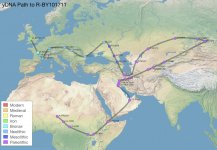Perhaps some support rather than nonsense would be warranted by you. Offer something or keep quiet. Iberia is clearly not the origination of DF27 based on the YSNP tree. Southern France would be consistent.
These are the oldest cases of Df27 that we know of. In Iberia, there was a massive founder effect with the two major branches of Df25, i.e. Z195 and ZZ12 represented since the beginning of the Bronze Age.
*EHU002 (2.434 BC)-Yacimiento de El Hundido-HapY-R1b-P312>DF27-Mit-K1a4/a1
*GBVPK (2.380 BC)- Grotte Basse de la Vigne Perdue-HapY-R1b1a/1b1a/1a2a/1-Z195-Mit-J2b1/a
*I8561 (2.272 BC)-Isnello, Sicilia-HapY-R1b-Df27-Z195-Mit-K1b1@16093
*I3123 (2.165 BC)-Buffa, Sicilia-HapY-R1b-Df27-Z195-Mit-U8b1/b1
*I3756-Castillejo del Bonete (1.897 BC)-HapY-R1b-DF27-ZZ12-A6387-BY61519-Mit-H1
*I3494-Coveta del Frare-(1.836 BC)-Hap Y-R1b-P312-DF27-ZZ12-BY3332-Mit-J1c1/b
*OBE3626-1-Obernai-Alsacia-(1.813 BC)-HapY-R1b-Df27-ZZ12>Z225>Z229/F1343-Mit-R1b
*I5441 (1.800 AC)-Neale's Cave, Paington, Devon-HapY-R1b-P312-Df27-Mit-H1@16239
*I1312d- Can Roqueta (1.782 BC)-HapY-R1b-Df27-Z195-Mit-HV0@195
*VAD001-Valdescusa (1.741 BC)-HapY-R1b-Df27-Z225-Z229*-Mit-U5b1
*I3397-Lloma de Betxí (1.741 BC)- HapY-R1b-Df27-Z195-Mit-K1a2/b
*Esp005-Cueva de los Lagos (1.700 AC)-HapY-R1b-DF27-ZZ12-Y3224-Mit-K1a
*I6470- Dolmen del Virgazal (1.651 BC)-HapY-R1b-Df27-ZZ12-Y30814-FGC33092-Mit-J1c1
*I10939-Cueva de Bray-(1.650 BC)-HapY-R1b-DF27-ZZ12-A6387-A11632-Mit-K1a3/a
*I4563- Galls Carboners (1.600 BC)-HapY-R1b-DF27-Z195-Z198-BY36372-Mit-H1/H84
*I12209- La Requejada (1.289 BC)-HapY-R1b-Df27-ZZ12-BY15964-Mit-H1ah
*WEZ59-Tollense (1.250 BC)-HapY-R1b-P312-Yleaf-R1b1a/1b1a/1a2a/1a-Df27-Z220-Mit-U5a2/b1a
1-El Hundido (2.434 BC)-We have a Df27 buried at the entrance of a Neolithic dolmen with grave goods typical of the Iberian BB culture-BB burial-Oval pit in the corridor of a dolmen-Male+45 years, 1,85 m, Brachicephally, fetal position in right lateral decubitus and with NO-SE orientation-Grave goods- Ciempozuelos style vessel, copper dagger, V perforated button, stone wristguard-
Y Chromosome Haplogroup assignments for ~2500 ancient samples-Reich Lab-Harvard- EHU002 belongs to R1b1a/1b1a/1a2a/7-DF27>DF83- Position (hg19)-22901108 - Position (hg38)-20739222-R-S24844/A12032-Ancestral Allele-C>TR1bP312>ZZ11_1>DF27>ZZ12>Z2559>FGC4920>DF83>Z2563>Z2567>CTS9545>CTS6519>FGC67201>Y15926>A11786>A12020/Y23959-Marker [S24844] currently considered coincident with marker [A12020], using that phylogenetic tree.
R1b1a/1b1a/1a2

312/S116/PF6547/MF52579
R1b1a/1b1a/1a2a/7:A12032/S24844
2-Grotte Basse de la Vigne Perdue- Archaeological material is characteristic of the Late Neolithic and the Early-Middle Bronze Age. In particular hemispherical V-perforated buttons could be attributed to early Bell Beakers-Iberic influence. Two pottery fragments of the later Pyrenean style, as well as turtle-shaped V-perforated buttons were also present. Two double-ended copper awls of square cross-section and one barbed-and-tanged arrowhead could be attributed to any of these two early Bell Beaker phases. Based on the radiocarbon dates presented here, individual GBVPK (2,461-2,299 cal. years BCE) is included in the late Bell Beaker timing period (Pyrenean-2.380 BC)-HapY-R1b1a/1b1a/1a2a/1-Df27-Z195 Mit-J2b1/a-Middle Bell Beaker- Geographically, the western part of the region from the Pyrenees and the Middle Garonne to central Languedoc was occupied by the Pyrenean group, while the eastern part, from eastern Languedoc to the Alps, was occupied by the Rhodano-Provençal group-Nothing suggests that the people of the Bell Beaker Culture were a population or group specialised in a specific kind of activity. Collective burials dominate (caves and rock shelters, hypogaea, dolmens, block tombs) and were frequently reused from the start of the 3rd millennium BC onwards. Pyrenean Group-
The best comparisons for the decorated pottery come once again from the Iberian Peninsula, but rather in Spain with the Ciempozuelos group (Garrido Pena 2000) for which some forms are identical to objects in the Rhodano-Provençal group (Lemercier 2003b). Some objects suggest other contacts, for instance microlit crescents point to contacts with Italy, while certain ceramic forms resemble forms in central or northern Europe. Domestic pottery seems to have been shared with other recent Bell Beaker groups across a large geographic area: in central Italy, Switzerland, the Rhône-Saône corridor to Normandy and along the Atlantic coast (Besse 2003; Leonini 2003).
Sicily (Isnello, Buffa)The presence of Steppe ancestry in Early Bronze Age Sicily is also evident in Y chromosome analysis, which reveals that 4 of the 5 Early Bronze Age males had Steppe-associated Y-haplogroup R1b1a/1a2a/1a2. Two of these were Y-haplogroup R1b1a/1a2a/1a2a/1 (Z195) which today is largely restricted to Iberia and has been hypothesized to have originated there 2500-2000 BCE. This evidence of west-to-east gene flow from Iberia is also suggested by qpAdm
modeling where the only parsimonious proximate source for the Steppe ancestry we found in the main Sicily-EBA cluster is Iberians
Then we have Df27 in Iberia, southern France and Sicily in deposits of the Bb culture. The pottery of the French site is identical to that of the Spanish site, and the Sicilians are of Iberian origin. The origin of Df27 is in the French-Cantabrian region, and from there it spread to the rest of Europe during the Bronze Age.






